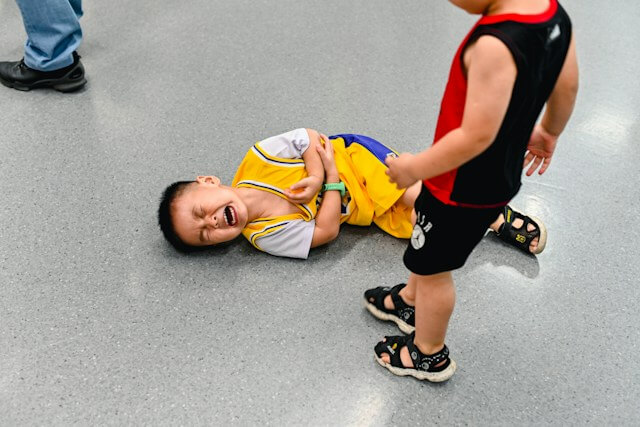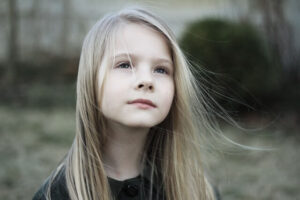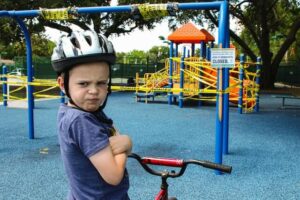
Table of Contents
Autism Spectrum Disorder (ASD) is a complex neurodevelopmental disorder that affects communication, behavior, and social interactions. One of the lesser-known manifestations of autism can be physical behaviors such as headbanging. This post aims to shed light on this behavior, its causes, and potential coping strategies.
What is Head Banging?
Head banging involves repeatedly hitting one’s head against a solid object, such as a wall or the side of a crib. It’s a self-soothing mechanism some children with autism use to cope with frustration, anxiety, or sensory overload.
Why Does it Happen?
Several reasons can explain why a child with autism might engage in headbanging:
- Sensory Processing Issues: People with autism often have difficulty processing sensory information. Head banging could be a way of coping with an overwhelming sensory environment or seeking sensory stimulation.
- Communication Challenges: Due to their difficulties with language and social interaction, children with autism may resort to head banging as a form of non-verbal communication to express needs or emotions.
- Frustration and Stress: Head banging can also serve as an outlet for frustration, stress, or discomfort, especially when the child struggles to express these feelings verbally.
Identifying Head Banging Triggers
Understanding the triggers for head banging is crucial for the appropriate support for both parents and caregivers of children with autism. These triggers for autism head banging in many children can be quite varied but commonly include:
- Overstimulation: Environments that are too chaotic or sensory-stimulating can trigger a child to head bang as they are in sensory overload.
- Understimulation: Conversely, a lack of sensory input can lead to head banging as the child seeks to create self-stimulation.
- Routine Changes: Individuals with autism often rely on predictable routines, and unexpected changes can result in stress, leading to behaviors such as head banging.
- Physical Pain: Sometimes, the root cause of head banging can be traced to physical discomfort or pain, such as headaches, ear infections, or toothaches.
- Emotional Distress: Emotional upheavals or anxiety can precipitate head banging as a coping mechanism.
Recognizing these triggers is a step toward minimizing them and helping children develop safer, more effective coping strategies.
How to Respond to Head Banging
Addressing head banging requires patience, understanding, and often professional guidance. Here are some strategies that can help with autism head banging:
Identify Triggers: Keep a record of when your child engages in headbanging. What happened before, during, and after each incident? Identifying patterns can help pinpoint triggers, whether they’re environmental, emotional, or related to certain activities.
Create a Safe Environment: Minimize the risk of injury by padding areas where your child tends to bang their head.
Teach Alternative Behaviors: Occupational therapists often recommend teaching children alternative behaviors that can fulfill the same function as head banging but are safer and more socially acceptable. This could include using a stress ball, listening to calming music, or engaging in deep pressure activities.
Professional Support: Consult with professionals such as pediatricians, psychologists, and occupational therapists who can provide insights and strategies tailored to your child’s specific needs.
Functions of Behavior and Headbanging in Autism
Understanding the connection between headbanging and the functions of behavior in individuals with autism spectrum disorder (ASD) is crucial. Behavioral analysts categorize the underlying reasons for behaviors like headbanging into four primary functions: attention-seeking, escape, access to tangibles, and sensory stimulation[^9^]. Often, headbanging is a form of communication used by an individual to meet these needs when they cannot do so through other means. For example, a child may headbang to escape a demanding situation or to gain attention from caregivers. Alternatively, the behavior could serve as a means to achieve sensory stimulation, especially in under-stimulated environments. Recognizing these functions helps in crafting effective intervention strategies that address the root causes of self-injurious behaviors in individuals with ASD.
Head Banging interventions
Functional Communication Training (FCT)
Functional Communication Training (FCT) is sometimes used to reduce self-injurious behavior in individuals with autism. This approach involves teaching the individual alternative communication methods to express their needs, reducing the need for self-harm. In addition to FCT, other behavioral interventions that may be helpful in addressing headbanging include positive reinforcement, providing a structured and predictable environment, and teaching coping skills to manage anxiety. Physical therapy and sensory integration therapy can also be beneficial for individuals with autism who engage in headbanging behavior.
Applied Behavior Analysis (ABA) therapy
Applied Behavior Analysis (ABA) therapy is a highly regarded intervention strategy for individuals with autism spectrum disorder, particularly for addressing challenging behaviors like headbanging. ABA therapy focuses on understanding and modifying behavior through a systematic process of assessment, goal-setting, and intervention based on the principles of behavioral psychology. For headbanging, ABA therapists work to identify the antecedents (what happens before the behavior) and consequences (what happens after the behavior) to understand its function. This insight allows therapists to develop personalized strategies aimed at reducing the occurrence of headbanging by teaching alternative, more adaptive behaviors that fulfill the same need for the individual, whether it be for sensory regulation, communication, or as a response to environmental stressors. Furthermore, ABA therapy often involves collaboration with other professionals to ensure a holistic approach to the individual’s well-being, addressing the multifaceted nature of headbanging and its impact on the person’s life.
Conclusion
Understanding autism and headbanging requires empathy and patience. While it can be distressing to witness, remember that your child isn’t trying to self harm themselves intentionally. They’re simply trying to cope with their emotions or sensory experiences in the best way they know how. With professional guidance, you can help your child find safer and more effective coping strategies.
Remember, every child with autism is unique. What works for one might not work for another. Always strive to understand and respect your child’s individual needs and experiences.
Disclaimer: This article is intended to provide general knowledge about autism and head banging, and should not be used as a substitute for professional medical advice or treatment. If your child is displaying these behaviors, please seek professional help.
- Autism Routine Disruption in Adults: Coping Tips - July 16, 2024
- Autism and Obsession: An Overview - July 16, 2024
- Autism and Taking Clothes Off: Management Tips - July 16, 2024



